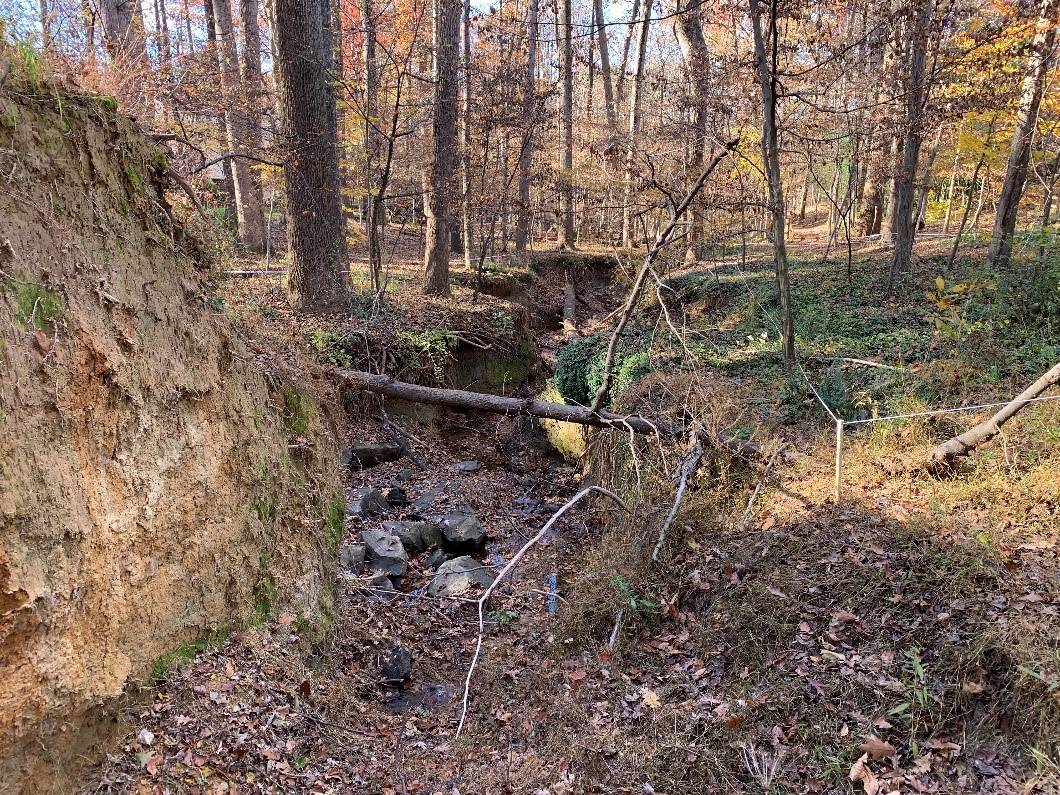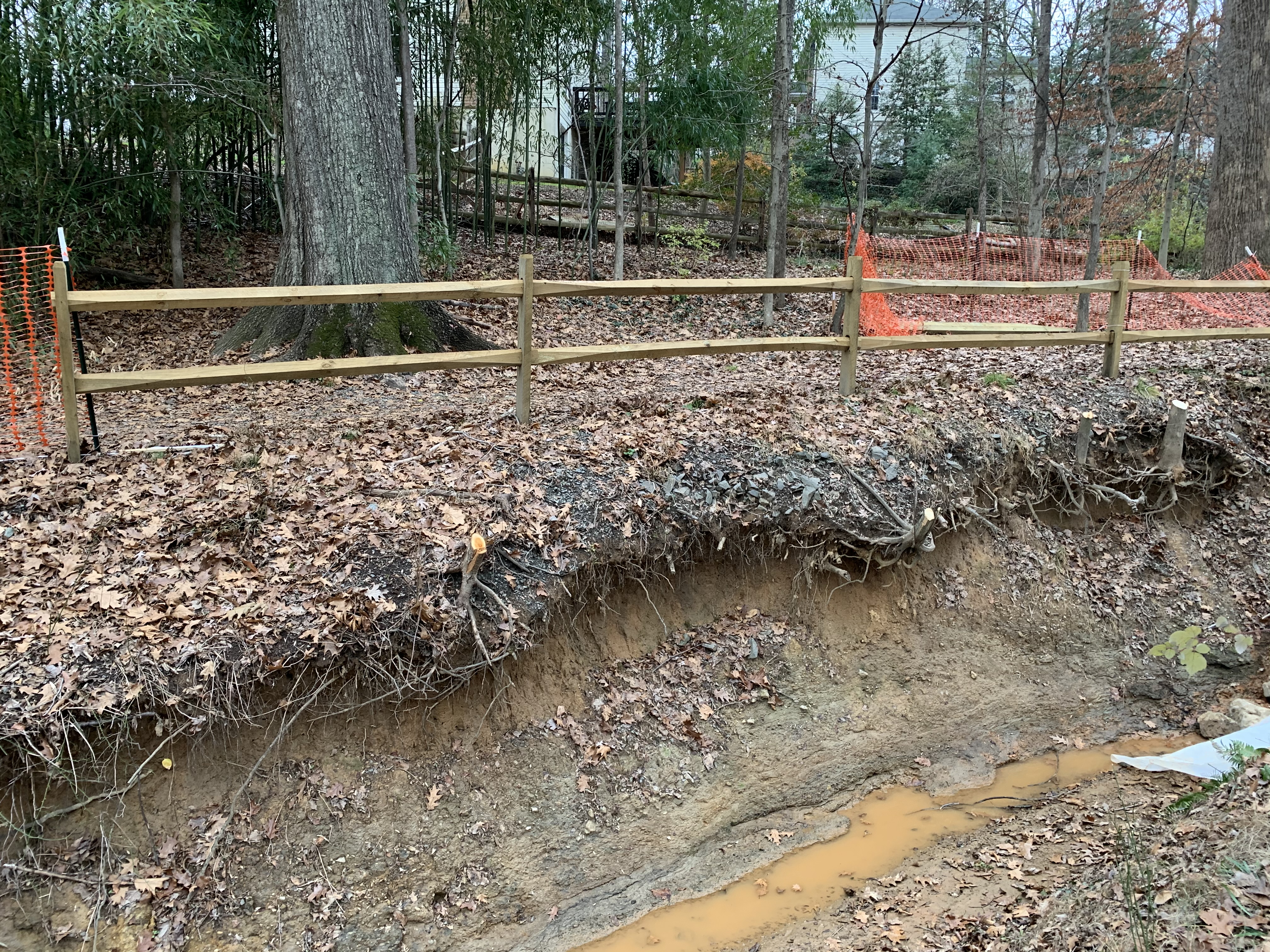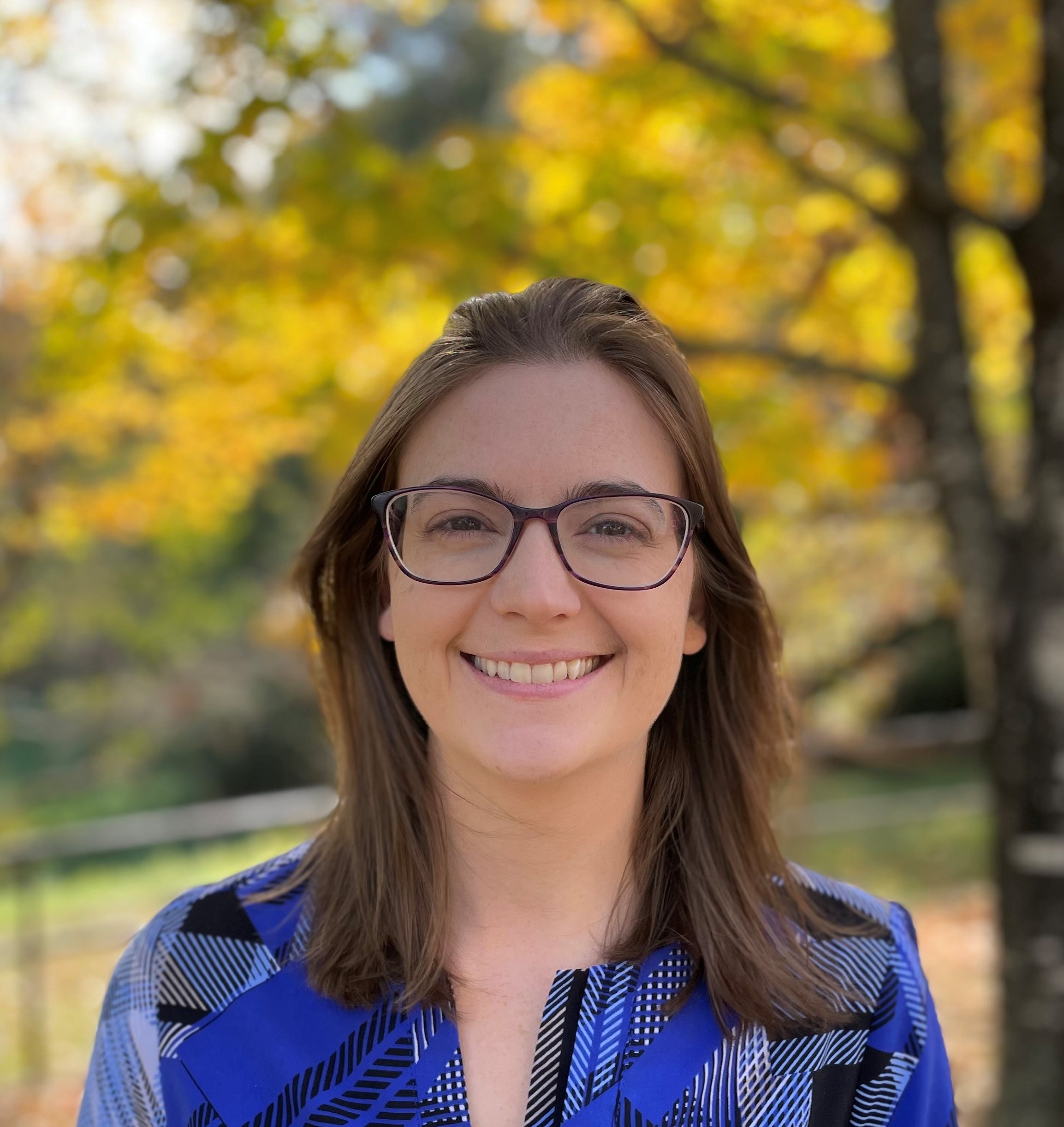Alums exemplify cross-sector leadership, collaborate to restore stream
December 14, 2021

By Rachael Holland, Chad Heflin, and Kyle Hatterick
Three Executive Master of Natural Resources (XMNR) graduates—Rachael Holland (XMNR ’17), Chad Heflin (XMNR ’18) and Kyle Hatterick (XMNR ’19)—recently completed the Miller Heights Outfall Restoration project in Fairfax County, Virginia. Each works for one of the cross-sector partners involved in the project and were pleased to find that the professional skills they learned in the XMNR program helped them collaborate more effectively. “Kyle and I have worked together on multiple projects and have found a great appreciation for the knowledge and leadership that the other person brings,” recalls Chad, who works as an Associate Ecosystem Restoration Specialist with Wetland Studies and Solutions, Inc. (WSSI). “I remember meeting Rachael for the first time and asking her about the Global Sustainability backpack that she was wearing, and from that conversation, we realized we had three XMNR alums on a single project that were in consecutive cohorts.”
“I thought it was pretty neat that the XMNR program was so well represented,” says Rachael, whose organization, the Fairfax County Department of Public Works Maintenance and Stormwater Management Division, was the owner of the project. “After reflecting on why that impressed me, it came down to the cross-sectional strength of the XMNR. Even though we each had distinct backgrounds and strengths, XMNR still gave us new competencies and perspectives to further our careers.”
“The skills that I took away from the XMNR I am able to directly incorporate into my career,” says Kyle, who works at Resource Environmental Solutions (RES), the contractor. “Every project has a unique set of stakeholders with different perspectives and needs. This project that Rachael, Chad, and I first worked on together exemplified that, in working with a cross-functional team that spanned public and private needs. Working with two other XMNR alums was exciting to me because I knew the skill sets that Rachael and Chad had, which led to creative problem-solving while incorporating our different backgrounds when looking at challenges as they came about.
The project
The Miller Heights Outfall Restoration Project consisted of the restoration of 412 linear feet of eroded outfall channel, a waterway that connects the end of piped storm sewer networks to larger rivers and their tributaries, located in Fairfax County Park Authority’s Difficult Run Stream Valley Park. The goals of the project were to address public safety concerns, stabilize a deeply eroded channel by using natural channel design techniques, provide enhanced water quality, and restore with native forest and riparian plantings. The project was largely completed on March 11, 2021.

The project owner’s perspective, by Rachael Holland
“The project got started when it came to the attention of my boss, Jack Meritt. We work in the Fairfax County Department of Public Works and Environmental Services (DPWES), Maintenance and Stormwater Management Division, so it is our job to maintain the County’s stormwater infrastructure. Most of the County is served by a piped storm sewer network, which conveys stormwater runoff to our streams. Our outfall projects are in small open channels that connect the end of the piped system with the larger streams. The outfall channels are located throughout the County, usually in natural areas like resource protection areas in homeowner association-owned property, in parks, and even in backyards.
Jack worked with WSSI and RES during project design and initiation. I joined the project just as it was starting construction. I coordinated weekly progress meetings with all stakeholders, including community representatives. I listened to community input and helped to address or allay their concerns. As the owner, I performed oversight and approved invoices for the work performed under contract to DPWES.
As a representative of the owner, my guiding interests are to be a good steward of public funds while addressing the specific needs and concerns of the communities that are impacted by our outfall channel projects. In the case of Miller Heights, the eroding channel was adjacent to a trail, which created a hazard to pedestrians who would not be able to see the steep drop from the trail. In the very beginning, there wasn’t even a fence, which was added as an interim safety measure until restoration of the channel was complete, and remained as a permanent feature after construction.


My job requires a combination of hard and soft skills. I chose XMNR for my graduate degree because of its intersection of leadership competencies and the field of sustainability. In the years after, I would say the biggest benefit I gained was perspective—of myself, others, and the many values and systems that comprise sustainability.
The design firm’s perspective, by Chad Hefflin
As a Wetland Studies and Solutions, Inc. employee, I continually have a hand in outfall and stream restoration projects in Fairfax County, Virginia. Projects like these are assessed and designed by our scientists and engineers, and the implementation of that design is then overseen in the field by our Ecosystem Restoration staff, such as me.
During the delivery of the project, my role is to consult with the owner (Fairfax County Representative) on submittal review, design installation, material specifications and quantities, and plant installation. I am on site daily to ensure the quality of the project, provide daily reports to the client, and ensure the contractor's installation is true to our firm’s design.
We are aiming to help stabilize this stream from the intense stormwater runoff it receives from the surrounding impervious surfaces. The stream degrades over time, and the incised channel continues to cause the banks to erode. One of the project goals was to raise the stream bed, which in turn allows the water to interact with the naturally existing floodplain during high flow events. This lets the stream dissipate its energy, helping reduce the likelihood of erosion.
Some projects also focus on limiting Total Maximum Daily Loads (TMDLs) of nutrients that come from the roads or lush green lawns of homeowners or golf courses and eroding banks. By connecting the stream back to the riparian area through the restoration process, it is naturally able to filter the water and improve water quality. Wetland Studies and Solutions, Inc. produces a bioengineered design that is reviewed and approved by our client (Fairfax County) and implemented by a construction contractor. The natural stream design is a mix of rock and woody structures, and during the dormant season, once the construction is complete, the riparian area and stream corridor are planted with native trees and shrubs to help boost the ecosystem and to provide another layer of stabilization by establishing root systems.
The XMNR prepared me for this type of work in many ways, including by helping me better understand how to navigate a public–private partnership and the importance of natural resource resilience and sustainability. My success on this project and many others can be accredited not only to the great company I work for, but to the XMNR for molding me into the professional individual I am today.
The contractor’s perspective, by Kyle Hatterick
My role as the project manager for Resource Environmental Solutions (RES) is to bring the two-dimensional plan set to life. Every day I work in highly sensitive areas: active waterways, under tree canopy, public and private property. My main job is to navigate the different constraints and lead the crew in implementation. Daily activities are communicating with the client (Fairfax County), ensuring proper control measures are functioning, coordination of resources (crew personnel, equipment, subcontractors, and materials), and scheduling and sequencing of activities. The most exciting part of my job is the brainstorming that occurs to overcome obstacles. A goal of every ecological construction project is to leave the site better than we found it. Many projects, including this one, had challenging access requirements and tight tolerances that needed to be met in order to achieve the project goals, which often takes creative thinking. None of this is done without the aid of a team; buy-in is needed, not just from the RES team but from the entire project team, to have a successful project.
The XMNR program helped me think more holistically about problems, not just from a contractor’s point of view. Each stakeholder in a project needs to be addressed, and sometimes there is even conflict resolution that needs to be done. This project is a reminder to me of how important effective communication is when working with a stakeholder who is unfamiliar with the process that is occurring, and how important working with a team is.
A successful outcome
The project has been a success, earning commendation from County Supervisor Palchik: “The MSMD team, led by Jack Meritt and Rachael Holland, had a collaborative approach, was in continuous communication with the neighborhood, and was willing to make modifications and concessions based on community input. This maintenance project restored a degraded outfall channel by using natural stream design techniques. On behalf of the community, I would like to thank the team for improving the area and making it safer for everyone.”
“The County has contracts with both RES and WSSI, so we should have the opportunity to all work together again. Obviously, we’d hope to repeat the success here,” says Rachael.
“What a great pleasure it was to work with Kyle and Rachael on this project,” says Chad, “and I look forward to working with them more in the future.”
“I am fortunate to be able to work on such rewarding projects that benefit the county in which I grew up. Transforming a stream that is in rough shape back to an ecosystem that can thrive is truly impactful,” says Kyle.
All three alums agree that, on a broader level, they feel prepared to effectively navigate future challenges using the competencies gained from XMNR.

Rachael Holland (XMNR ’17) is a Professional Engineer with the Fairfax County Department of Public Works Maintenance and Stormwater Management Division, whose work focuses on the maintenance of stormwater outfalls and channels in County easements. She holds a bachelor’s degree from Cornell University and is a LEED Accredited Professional in Building Design and Construction.

Chad Heflin (XMNR ‘18) is an Associate Ecosystem Restoration Specialist with Wetland Studies and Solutions, Inc. (WSSI), where he oversees the implementation of natural stream and wetland design restoration projects in Northern Virginia. Chad holds a bachelor’s degree in Agribusiness from Ferrum College and is an ISA Certified Arborist and a Wetland Professional in Training (WPIT).
Kyle Hatterick (XMNR ’19) is a Construction Project Manager for Resource Environmental Solutions (RES), who manages stream restoration and wetland enhancement projects in the Northern Virginia Region that utilize low impact designs. Kyle has a Bachelor of Science from James Madison University in Integrated Science and Technology, where his studies focused on water quality and riparian systems.


